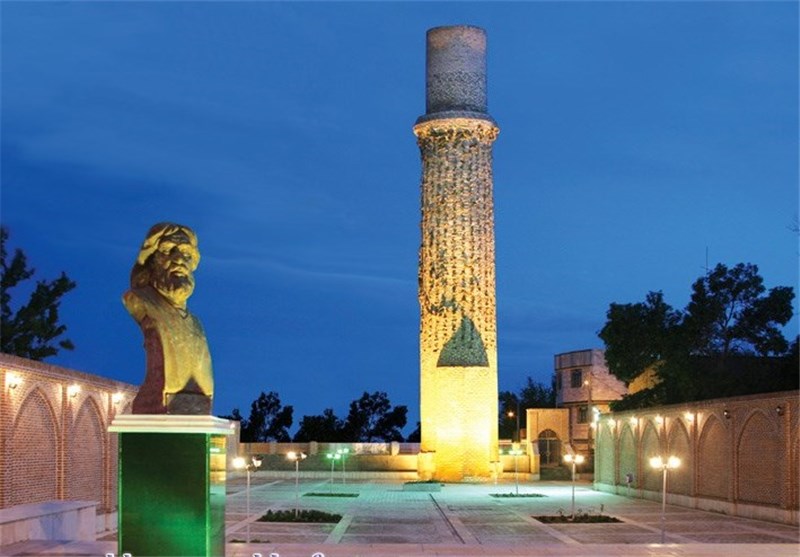Tehran, YJC. The shrine of famous Iranian mystic Shams Tabrizi is a favorite place for the coming days of New Year to visit.
Shams-i-Tabrīzī or Shams al-Din Mohammad (died ca.1248) was a Persian Muslim, who is credited as the spiritual instructor of Mawlānā Jalāl ad-Dīn Muhammad Balkhi, also known as Rumi and is referenced with great reverence in Rumi’s poetic collection, in particular "Diwan-i Shams-i Tabrīzī” (The Works of Shams of Tabriz).

Tradition holds that Shams taught Rumi in seclusion in Konya for a period of forty days, before fleeing for Damascus. The tomb of Shams-i Tabrīzī has recently nominated to be a UNESCO World Heritage Site. Contents
The Life of Shams-i Tabrīzī
According to Sipah Salar, a devotee and intimate friend of Rumi who spent forty years with him, Shams was the son of the Imam Ala al-Din. In a work entitled Manāqib al-‘arifīn (Eulogies of the Gnostics), Aflaki names a certain ‘Ali as the father of Shams-i Tabrīzī and his grandfather as Malikdad. Apparently basing his calculations on Hajji Bektash Wali's Maqālāt (Conversations), Aflaki suggests that Shams arrived in Konya at the age of sixty years. However, various scholars have questioned Aflaki’s reliability.
Shams received his education in Tabriz and was a disciple of Baba Kamal al-Din Jumdi. Before meeting Rumi, he apparently traveled from place to place weaving baskets and selling girdles for a living. Despite his occupation as a weaver, Shams received the epithet of "the embroiderer” (zarduz) in various biographical accounts including that of the Persian historian Dawlatshah. This however, is not the occupation listed by Hajji Bektash Wali in the ”Maqālat” and was rather the epithet given to the Ismaili Imam Shams al-din Muhammad, who worked as an embroider while living in anonymity in Tabriz. The transference of the epithet to the biography of Rumi’s mentor suggests that this Imam’s biography must have been known to Shams-i Tabrīzī’s biographers. The specificities of how this transference occurred, however, are not yet known. Shams’ encounter with Rumi
In 1244, a man in black suit from head to toe, came to the famous inn of Sugar Merchants of Konya. His name was Shams Tabrizi. He was claiming to be a travelling merchant. As it was said in Hajji Bektash Wali's book, "Makalat", he was looking for something. Which he was going to find in Konya. Eventually he found Rumi riding a horse.
One day Rumi was reading next to a large stack of books. Shams Tabriz, passing by, asked him, "What are you doing?" Rumi scoffingly replied, "Something you cannot understand." On hearing this, Shams threw the stack of books into a nearby pool of water. Rumi hastily rescued the books and to his surprise they were all dry. Rumi then asked Shams, "What is this?" To which Shams replied, "Mowlana, this is what you cannot understand."
A second version of the tale has Shams passing by Rumi who again is reading a book. Rumi regards him as an uneducated stranger. Shams asks Rumi what he is doing, to which Rumi replies, "Something that you do not understand!" At that moment, the books suddenly catch fire and Rumi asks Shams to explain what happened. His reply was, "Something you do not understand."
After several years with Rumi in Konya , Shams left and settled in Khoy. As the years passed, Rumi attributed more and more of his own poetry to Shams as a sign of love for his departed friend and master. In Rumi's poetry Shams becomes a symbol of God's love for mankind; Shams was a sun ("Shams" means "Sun" in Arabic) shining the Light of God on Rumi
Death
Shams Tabrizi died in Khoy and is buried there. His tomb has been nominated as a World Cultural Heritage Center by UNESCO.[9] A saint by the name of Shams-i Tabrīzī is also buried at Multan, Pakistan. The tomb stone clearly indicates it is the same Shams-i Tabrīzī, who was the spiritual mentor of Rumi. But this is wrong actually this tomb belongs to Hazrat Pir Shamsuddin Sabzwari Multani who is the pir of the Ismaili spiritual and theological school.


